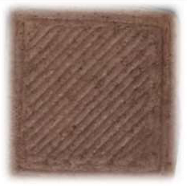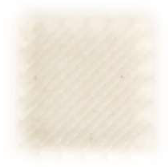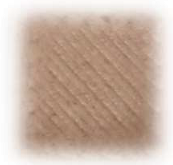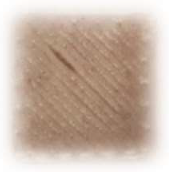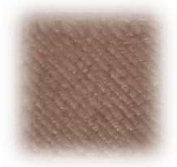Abstract
Three-dimensional (3D) food printing (3DFP) is an emerging technology that enables the creation of personalized and functional foods by precisely controlling nutritional content and shape. This study investigated the 3D printability and rheological behavior of cereal–legume starch-based gels formulated with germinated brown rice (GBR) and red adzuki bean (RAB) flours, supplemented with xanthan and guar gums as functional additives. The physicochemical and structural properties of the gels were characterized through FT-IR, rheology, texture analysis, SEM, and sensory evaluation. In addition, the 3D printing fidelity, rheological behavior, color attributes, textural properties, microstructure, and sensory scoring of the printed products were evaluated. The results indicated that the gels exhibited pseudoplastic behavior, with the RABF/GBRF ratio of 1:2 (RG1:2) formulation showing optimal color properties (ΔE* = 0.60 ± 0.86) and the RABF/GBRF ratio of 2:1 (RG2:1) formulation demonstrating superior printing fidelity and structural stability (printing accuracy = 99.37 ± 0.39%). The gels’ mechanical properties, such as hardness and chewiness, were significantly influenced by the RABF and GBRF ratios, with RG2:1 exhibiting the highest hardness (1066.74 ± 102.09) and RG1:2 showing the best springiness (0.64 ± 0.10). The sensory evaluation results indicated that the RABF/GBRF ratios of 1:1 (RG1:1) and RG1:2 had relatively high overall acceptance scores. These findings indicate that specific ratios of RABF and GBRF improve the 3D printability and textural properties of cereal–legume starch-based gels, enhancing their suitability for 3D food printing applications. This study provides valuable insights into the development of personalized and functional cereal–legume starch-based foods using 3DFP technology.
1. Introduction
Three-dimensional (3D) food printing, also known as food layering manufacturing technology, is a digitally controlled process that uses 3D solid models as a basis and enables food materials to be printed layer by layer to create complex and varied food products by controlling temperature or pressure [1,2,3]. Three-dimensional food printing (3DFP) technology allows the customization of food products to meet individual physiological and nutritional needs by modifying nutrient content, reducing undesirable compounds, and incorporating health-promoting components such as fiber, protein, and phytochemicals [4,5]. Therefore, 3DFP technology can not only enrich food styles and improve food quality but also precisely regulate the nutritional content of food to meet the health needs and taste preferences of different individuals (such as the elderly, children, and athletes) [6,7]. Meanwhile, the use of 3D printing technology enables the realization of complex shapes and structures that are difficult to construct by traditional processing methods [8]. Compared to traditional food production, 3DFP technology addresses the growing demand for personalized and functional foods and has great development prospects in the food processing and manufacturing industry [7].
Cereals and legumes are essential components of the human diet and play a pivotal role in global dietary patterns [9]. Germinated brown rice (GBR), a representative cereal grain, and red adzuki beans (Vigna angularis) (RAB), a representative legume, are valuable resources for food development due to their rich starch content and diverse bioactive compounds [10,11]. Three-dimensional food printing technology offers significant advantages in achieving personalized product design, precise nutritional formulation, and accurate dosage control, making it particularly suitable for the innovation of cereal–legume starch-based food products [12]. Currently, a wide range of materials, including chocolate [13], cheese [14], cereals [15], and ground meat [16], have been successfully applied in food 3D printing. Through straightforward modifications and nutritional optimization of these materials, it is feasible to produce healthier 3DFP products [17]. For example, Khemacheevakul et al. [18] employed dual-extrusion 3D printing technology to fabricate chocolate layers with varying sugar concentrations, effectively reducing overall sugar content while maintaining optimal sweetness perception, thereby creating a healthier low-sugar chocolate alternative. Similarly, Riantiningtyas et al. [19] utilized 3DFP technology to develop protein-enriched desserts using yogurt–gel inks with different concentrations of gelatin and whey protein isolate (WPI). Their findings demonstrated that increased gelatin content enhanced gel strength, while WPI contributed to gel softening but improved post-printing shape stability, with optimal gelatin-WPI combinations achieving balanced texture, appearance, and sensory properties. Furthermore, Yu et al. [20] conducted a comprehensive investigation of the effects of varying konjac gum to xanthan gum ratios on the rheological properties, printability characteristics, textural attributes, microstructure formation, and protein–glycan interactions of cooked sturgeon paste. This research ultimately led to the development of a textured sturgeon paste suitable for individuals with swallowing difficulties. Despite these advancements, research on the 3DFP of GBR and RAB flour remains limited. Given their high content of starch, dietary fiber, protein, and other nutritional components, coupled with the excellent gelation and gelatinization properties of starch-based foods, GBR and RAB present promising potential as 3DFP materials [21].
The extrusion-based 3DFP technique is one of the common food 3D printing technologies [22]. In food 3D printing, the selection of raw materials plays a pivotal role in determining the quality characteristics of printed products [23]. To enhance printability, base materials, particularly cereal and legume flours, are typically combined with food hydrocolloids such as xanthan gum and guar gum to formulate composite gels with optimal 3D printing properties [20]. Among various food hydrocolloids, xanthan gum exhibits distinctive rheological properties, demonstrating excellent water solubility and remarkable stability under diverse conditions, including heat, acid, and alkaline environments. These characteristics enable its versatile application as a thickener, emulsifier, and stabilizer in the food industry [24]. Similarly, guar gum, a high-molecular-weight natural hydrocolloid, serves as one of the most prevalent quality enhancers and natural thickeners in food processing [25]. The incorporation of appropriate quantities of xanthan and guar gums not only optimizes nutritional profiles and enhances textural properties but also significantly improves the structural stability of 3DFP products [26].
This study adopts an attempt by maintaining consistent levels of food additives while systematically modifying the proportions of primary food components to facilitate 3D food printing. Specifically, GBR and RAB flours were selected as base materials, supplemented with xanthan gum and guar gum, to develop a cereal–legume starch-based food gel designed for extrusion-based 3DFP. The specific objectives of the current study are as follows: (1) to investigate the gelation characteristics of GBR and RAB flour-based gels with varying formulation ratios and (2) to assess the 3D printing performance and resultant product quality of GBR and RAB flour-based gel foods.
2. Materials and Methods
2.1. Preparation of the Gel
The preparation of GBR was conducted with reference to Zhu et al. [27], and the RAB samples were supplied directly by the Processing Research Institute, Heilongjiang Academy of Agricultural Sciences. The freeze-dried germinated brown rice flour (GBRF) and red adzuki bean flour (RABF) were sifted using an 80-mesh sieve.
The preparation of the cereal–legume starch-based gel was adapted from Huang et al. [28] with appropriate modifications and refined based on preliminary experiments. The flowchart of the gel preparation and 3D printing process is illustrated in Figure 1.
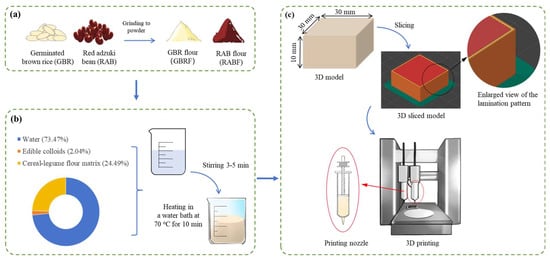
Figure 1.
Flowchart of gel preparation and 3D printing process. (a) Preparation of GBR flour and RAB flour; (b) preparation of cereal–legume starch-based gel; (c) 3D printing process of the gel.
The RABF and GBRF in different proportions (Table 1) were used as base materials. These were subsequently combined with a hydrocolloid mixture consisting of 2% xanthan gum (XG) and guar gum (GG), maintaining a xanthan gum to guar gum (XG-GG) ratio of 2:5 (w/w). The blend was then hydrated with boiling distilled water (98.0 ± 0.3 °C) at a material-to-water ratio of 1:3 (w/w), followed by thorough mixing for 3–5 min to ensure homogeneous distribution. To enhance molecular interactions and facilitate network formation, the mixture underwent thermal stabilization in a 70 °C water bath for 10 min. Following thermal treatment, the samples were cooled to ambient temperature, resulting in the formation of gel samples, which were subsequently stored at 4 °C for further experimental analysis. All experiments were carried out at room temperature (25 ± 1 °C).

Table 1.
Experimental formulations of the gel for 3D printing.
An experimental scheme shown in Table 1 was developed based on the existing literature reported by Yu et al. [20] and our preliminary experimental results. Based on these trials, three representative ratios of RABF/GBRF—1:1, 1:2, and 2:1—were selected for gel preparation and subsequent analysis.
2.2. Characterization of Gel Properties
In order to evaluate the characteristics of the prepared gel, the chemical interactions between materials and XG-GG, rheological properties, and the microstructure of the gel were characterized and analyzed.
2.2.1. Fourier Transform Infrared Spectroscopy (FT-IR)
The FT-IR spectra of the gel were measured using an FT-IR spectrometer (IRAffinity-1S, Shimadzu, Kyoto, Japan) according to the method described by Zhu et al. [27]. The spectrum was recorded over a wavenumber range of 400 to 4000 cm−1 with a resolution of 4 cm−1. A KBr blank tablet was used as a reference.
2.2.2. Static and Dynamic Rheological Properties
A rotational rheometer (Discovery HR-2, TA Instruments, Inc., New Castle, DE, USA), equipped with 20 mm parallel plates and 1000 μm spacing, was used to perform full rheological characterization of the gel. The experimental operation was adapted from the previous methods with necessary modifications [28]. Water evaporation was prevented by sealing the edges with silicone oil and preheating at 25 °C for 5 min to reach equilibrium. Static rheology was scanned at shear rates from 0.1–10 s−1 to resolve hydrodynamic properties. For dynamic rheological analysis, frequency sweep tests were conducted within the range of 0.1–10 Hz at a constant strain of 2%. Creep tests were performed at 30 Pa for 300 s to characterize the material stress response. The obtained shear curves were fitted using Equation (1) [29]:
where η is the viscosity of the gel sample (Pa·s); γ is the shear rate (s−1); K is the consistency (Pa·s); and n is the power-law index. For a pseudoplastic solution, n < 1.
Similar to the static rheological measurements, in dynamic rheological measurements, the storage modulus (G′) versus loss modulus (G″) and the tangent value of the loss angle (tanδ) were obtained as a function of frequency by scanning at 1–100 rad/s with 0.1% strain [30] and were used to assess elastic and viscous properties within the linear viscoelastic region. The frequency function tanδ is defined by Equation (2) [30]:
2.2.3. Scanning Electron Microscopy (SEM)
SEM (S-3400 N, Hitachi, Tokyo, Japan) was used to observe the microstructural morphology of the gel according to Shen et al. [31]. Briefly, the sample was cut into ultra-thin slices and then uniformly adhered to conductive tape, followed by the application of a gold coating to their surfaces. Micrographs of the gel were then taken at an accelerating voltage of 5 kV, and the microstructural changes were observed at a magnification of 1500×.
2.3. Color Measurement of the Gel
The color of the gel was measured by using a colorimeter (CR-20, Konica Minolta Inc., Tokyo, Japan). The color scale was expressed in terms of L*, a*, and b* based on the CIE-Lab color space [31]. L* represents brightness or darkness between 0 (black) and 100 (white), and a* represents redness (+) or greenness (−), while b* represents yellowness (+) and blueness (−). Based on these, the total color difference (ΔE*) can be further calculated:
where L0*, a0* and b0* are the color values of the initial samples; L*, a*, and b* are the color values of treated samples.
2.4. 3D Printing Process of the Gel
The 3D printing performance of the gel was assessed using an extrusion-based food 3D printer (FoodBot-D1, Shiyin Technology Co., Ltd., Hangzhou, China). A rectangular model measuring 30 mm in length, 30 mm in width, and 15 mm in height, designed in SolidWorks software (Ver. 2024, Dassault Systemes, Waltham, MA, USA), served as the printing model. Prior to printing, the printer parameters were configured via Slic3r software (Ver. 1.2.9) with the following settings: nozzle diameter of 1.2 mm, initial layer height of 0.84 mm, printing speed of 25 mm/s, concentric fill pattern, and 90% fill density.
2.4.1. Determination of Printing Fidelity
The printed samples were stored in an airtight glass container at 4 °C for 0, 0.5, 1, 1.5, and 2 h, after which their dimensions (length, width, and height) were measured. Shape stability was evaluated using the shape stability index (SSI), as defined in Equation (4) [32]
where sample size before treatment represents the volume before deformation; sample size after treatment refers to the volume after deformation.
2.4.2. Determination of Gel Texture
To comprehensively evaluate the textural properties of the 3D-printed samples, a texture analyzer (Stable Micro System Ltd., TA.XT Plus, Surrey, UK) was employed to conduct a two-cycle texture profile analysis [33]. A cylindrical probe (P/50, 50 mm diameter) was used to compress the samples to 45% of their original height, ensuring adequate assessment of material deformation. The trigger force was set to 5 g for precise and gentle probing. During the test process, a pre-test speed of 1 mm/s, test speed of 5 mm/s, and post-test speed of 5 mm/s were set to ensure consistent and reliable data collection. The textural parameters, including hardness, adhesiveness, springiness, cohesiveness, stickiness, and chewiness, were recorded according to TPA curve attributes [34].
2.5. Sensory Evaluation
The experimental methods outlined by Li et al. [35] and Islam et al. [36] were referenced and appropriately modified for sensory evaluation. A total of ten trained participants, five females and five males, were selected for the sensory evaluation, which was repeated three times. Each participant was randomly assigned to samples of different formulations. Sensory evaluation indicators included color, smell, taste, texture, appearance, and overall acceptability, as shown in Table 2. The rating scale ranges from 0 to 8, where “0” indicates that the sample is unacceptable and “8” indicates that it is highly liked. The final score was the average of the results collected from all participants.

Table 2.
Sensory scoring criteria.
2.6. Statistical Analysis
The test results were expressed as the mean ± standard deviation (SD) based on three replicates. The OriginPro software (Ver. 2023b, OriginLab Corp., Northampton, MA, USA) was introduced for the graphical representation of the data, and SPSS statistical software (Ver. 19.0, SPSS Inc., Chicago, IL, USA) was used for statistical analysis.
3. Results and Discussion
3.1. FT-IR Analysis of the Gel
FT-IR spectroscopy has been extensively utilized in studying organic functional groups, as it enables the identification and determination of specific functional groups through their corresponding unique absorption peaks [37]. The FT-IR spectra of the gel prepared by various formulations are shown in Figure 2.
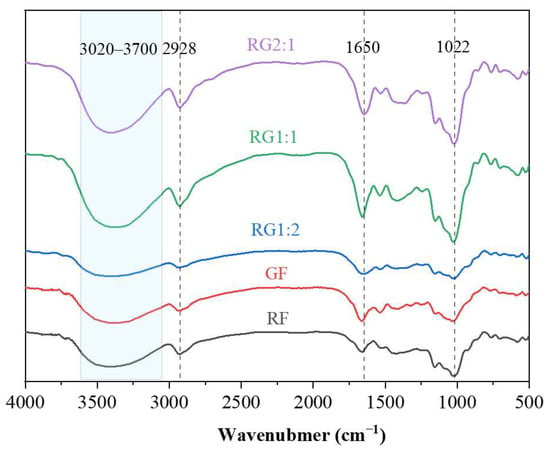
Figure 2.
FT-IR spectra of the gel prepared by various formulations. Note: The meanings of the symbols for gel types are detailed in Table 1.
The five various samples exhibited similar characteristic peaks, indicating that despite the differences between GF, RF, and their mixtures, they retained the typical chemical bonding modes within the gel system. The combination of GF and RF did not alter their functional groups or chemical bonding characteristics [27]. The broad peak at 3020–3700 cm−1 corresponds to the stretching vibrations of hydroxyl groups in starch molecules, indicating hydrogen bond strength in the samples. Compared to GF and RF, the intensity of this broad peak in RG samples was significantly enhanced. This suggested that combining the two flours (RABF and GBRF) formed stronger hydrogen bonds within the gel system than using either flour alone [38]. As a result, the gel structure remained more intact during the printing process.
Interestingly, as the proportion of GBRF increased (RG1:2 group), the intensity of the tensile vibration peak (3020–3700 cm−1) corresponding to hydroxyl groups decreased. This was attributed to the complex interactions between GBRF starch and the gel system. The peak at 1650 cm−1 was associated with the C-O stretching vibrations of the amide group in proteins. The peak at 2928 cm−1, related to -OH and -CH hydrogen bonds indicated the formation of starch–lipid complexes [39]. Additionally, the peak at 1022 cm−1, attributed to the stretching and bending vibrations of CO-, C-C, and OH- groups, as well as the asymmetric stretching of C-O-C glycosidic bonds, suggested interactions between lipids and proteins [40]. Based on the FT-IR spectrum, it was evident that no functional groups disappeared, and no new ones appeared in 3DFP, indicating that no new substances were generated during the process [41]. This further suggested that during the 3D printing process, only changes in the crystal structure took place, as opposed to alterations in the chemical structure, thereby guaranteeing the safety of the 3D-printed food products.
3.2. Static Rheological Properties
To understand the viscoelastic properties of gels used as 3D printing materials, Figure 3 illustrates how the apparent viscosity of gels with different formulations changes with shear rate, examining their steady shear rheological characteristics.
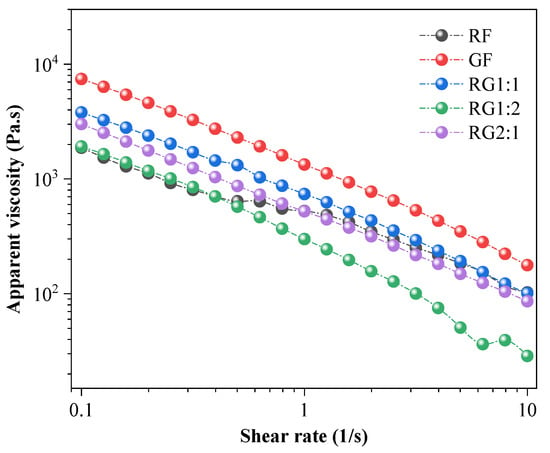
Figure 3.
Apparent viscosity versus shear rate profile for gels at different formulations. Note: The meanings of the symbols for gel types are detailed in Table 1.
From Figure 3, the apparent viscosity, as a key characteristic of pseudoplastic behavior, of the gels with different amounts of added GBRF and RABF decreased with the increase in shear rate. This indicated that the prepared gels showed pseudoplastic fluid properties and exhibited shear thinning behavior [42]. This may be due to the mutual entanglement between starch molecular chains; when the shear force increased, the structure between starch molecular chains underwent significant changes due to the change in the orientation of the large molecular chains, resulting in a decrease in flow resistance, that is, a decrease in apparent viscosity [43]. The quantitative confirmation was further supported by the fitted parameters in Table 3. Specifically, all samples exhibited flow behavior index (n) values within the range of n < 1, which was a widely recognized indicator of pseudoplastic (shear-thinning) fluids [44]. Moreover, the apparent viscosity for the GF gel reached the highest value, and the strength of the gel system was the highest. This was due to the formation of a denser network structure, which in turn increased the apparent viscosity [42]. The denser network structure in the GF samples could be observed through the SEM images in Section 3.4. The denser structure was attributed to specific interactions among the components in the GF formulation, potentially promoting tighter molecular entanglements and reducing free water mobility, where the similar findings were also reported by Liu et al. [45]. According to Equation (1), the relationship between apparent viscosity (η) and shear rate (γ) for the gels with different formulations was fitted to obtain the non-Newtonian exponent n and consistency coefficient K, as shown in Table 3.

Table 3.
The fitted parameters of n and K shown in Equation (1).
From Table 3, nearly all correlation coefficients (R2) were higher than 0.98, showing a strong power-law dependence of viscosity on shear rate [29]. In 3D printing processes, fluids begin to exhibit shear-thinning behavior when the power-law index n falls below 1 (n < 1). Mild shear-thinning characteristics were observed as n approaches 0.6, while significant shear-thinning effects became prominent when the index reached values of n ≤ 0.2 [46,47]. This suggested that to some extent, the smaller the value of n, the stronger the pseudoplasticity.
As shown in Table 3, the n values of all gel samples were between 0.2 and 0.3, demonstrating that both RABF and GBRF as well as their composite gels exhibited superior pseudoplasticity. Notably, the RG1:1 and RG1:2 formulations displayed comparable and lower n values, suggesting that these materials maintained higher viscosity under low shear conditions while demonstrating reduced viscosity and enhanced flow properties at elevated shear rates [48]. This rheological behavior was particularly advantageous for 3D printing applications, as it aligned well with the dynamic force variations experienced by the feedstock during the printing process, thereby facilitating material extrusion [49]. The parameter K indicates the material’s consistency. A lower K value facilitates smoother material flow during the 3D printing process, thereby enhancing printing accuracy [50].
3.3. Dynamic Rheological Properties
Figure 4 presents the dynamic rheological curves of the gels with different formulations, and the storage modulus (G′) and loss modulus (G″) employed to characterize the viscoelastic properties of the materials [51]. In general, both G′ and G″ increased with the increase in frequency, and G′ was found to be higher than G″, meaning a solid-like behavior of materials, reflecting the mechanical strength [30] and indicating that all samples were self-supporting and formed weak gels [51]. G′ represents the behavior of an elastic solid and reflects the mechanical strength of the material. Materials with higher G′ values typically exhibited superior mechanical strength and were more capable of preserving the printed geometry over time [30]. Among the tested samples, the G′ followed the order: GF > RG1:2 > RF > RG2:1 > RG1:1, aligning well with the apparent viscosity results discussed previously. A higher G′ value denoted improved mechanical robustness and structural resilience under external stress, which was particularly critical for ensuring dimensional fidelity in 3D-printed constructs.
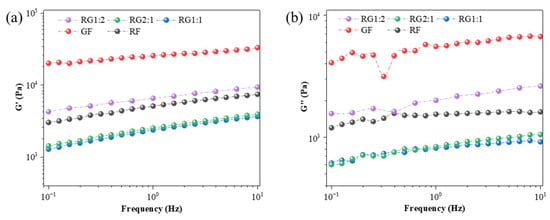
Figure 4.
Changes in dynamic rheological properties of the gels with different formulations. (a) Storage modulus of the gel (G′). (b) Loss modulus of the gel (G″). Note: The meanings of the symbols for gel types are detailed in Table 1.
A lower loss modulus G″ indicated reduced energy dissipation as heat during deformation, and heat loss was reduced. In this dimension, the ranking of GF > RG1:2 > RF > RG2:1 > RG1:1 also held true, with the RG1:1 gel performing particularly well in this respect, showing the advantage of energy conversion efficiency during the deformation process [52]. In addition, we calculated tanδ values (i.e., G″/G′). When the tanδ value approached zero, the properties of the sample were close to those of an ideal elastic solid. Conversely, when the tanδ value approached positive infinity, the properties of the sample were close to those of an ideal viscous fluid [53]. The calculated tanδ value was significantly lower than 1 and ranged from 0.2 to 0.5, confirming that all samples exhibited significant elasticity properties, albeit with some fluctuations. In particular, RG1:2, which indicated that this gel had the highest solid-like properties and the best moldability [54].
3.4. Microstructure Changes of the Gel
Figure 5 presents the microstructural morphology of gels with varying formulations at 1000× magnification, revealing significant differences in their structural characteristics. As depicted in Figure 5a,b, both RF and GF exhibited a dense architecture characterized by a textured surface and minimal porosity, suggesting a homogeneous distribution of starch granules within raw RAPF and GBRF matrices. In contrast, Figure 5c,d demonstrate that RG1:1 and RG1:2 possessed a more heterogeneous and disorganized morphology, albeit with a smoother surface texture. These samples displayed noticeable fractures and insufficient interparticle connectivity [55]. Notably, RG2:1 presented a less consolidated structure featuring a coarse surface and prominent pore formation, indicative of an emerging dense structural framework. These observations underscored the substantial influence of starch content in RAPF and GBRF on the microstructural properties of 3D-printed gel specimens. This phenomenon could be attributed to the enhanced molecular interactions between water and starch components at higher starch concentrations, which consequently reinforced the gel network and facilitated the development of a more compact structural configuration [32].
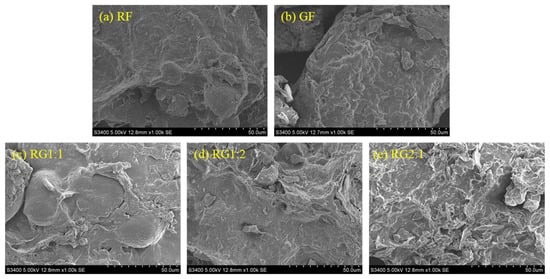
Figure 5.
Microstructural changes in 3D-printed samples with different formulations at 1000× magnification. (a) RF, RABF; (b) GF, GBRF; (c) RG1:1, RABF to GBRF ratio of 1:1; (d) RG1:2, RABF to GBRF ratio of 1:2; (e) RG2:1, RABF to GBRF ratio of 2:1. Note: The meanings of the symbols for gel types are detailed in Table 1.
3.5. Color Changes in the Gel
The visual color of the final product serves as one of the important reference criteria for consumers when selecting the optimal gel formulation. Table 4 shows the color changes in the gels and the actual color of the 3D-printed samples.

Table 4.
Color parameters (L*, a*, and b*) of gels and actual color of 3D-printed samples.
In terms of colorimetric properties, the GBRF-based gel (GF group) exhibited the highest brightness (L* value), while the RABF-based gel (RF group) showed the lowest brightness. Interestingly, when RABF and GBRF were mixed at a ratio of 1:2 (RG1:2 group), the resulting cereal–legume starch-based gel achieved the highest L* value, indicating optimal brightness. Regarding the a* value, which represents the red-green spectrum, the RF group had the highest value, suggesting a stronger red component, whereas the GF group had the lowest. The RG1:2 group demonstrated the lowest a* value, indicating a more balanced color profile. Similarly, the b* value, representing the yellow–blue spectrum, was highest in the GF group and lowest in the RF group, with the RG1:2 group showing a relatively low b* value. The color difference (ΔE*) was highest in the RG2:1 group and lowest in the RG1:1 group, with the RG1:2 group exhibiting a relatively low ΔE* value. Overall, the RG1:2 group demonstrated superior color properties, as evidenced by its balanced L*, a*, and b* values, as well as a low ΔE*.
The observed color differences can be attributed to the varying pigment compositions and interactions between the RABF and GBRF components. GBRF, rich in chlorophyll and carotenoids, likely contributes to higher brightness (L*) and yellowness (b*), while RABF, containing anthocyanins, may enhance the red component (a*). The optimal color properties of the RG1:2 group suggested a synergistic effect where the pigments from both sources interact to produce a visually appealing color. This phenomenon aligned with previous findings [56], where the blending of different plant-based materials often resulted in improved color stability and aesthetic appeal due to the complementary nature of their pigments [57]. Further research into the specific pigment interactions and their stability under different processing conditions could provide deeper insights into the mechanisms behind these colorimetric outcomes.
3.6. 3D Printing of the Gel
3.6.1. Printing Fidelity
In order to further evaluate the printing accuracy of the gel, the length, width, and height of the 3D-printed gel were measured, and then the shape stability index (SSI) value was calculated. The closer the SSI value is to 100%, the higher the accuracy, and the higher the printing fidelity [58]. Table 5 shows the changes in SSI values of the 3D-printed gel with different standing times from 0.5 to 2 h.

Table 5.
SSI values for evaluating the printing fidelity of 3D-printed gel.
As demonstrated in Table 5, the SSI of cereal–legume starch-based gels exhibited significant variations depending on the formulation and standing time. The GBR-based gel (GF group) displayed the highest SSI value, while the RAB-based gel (RF group) showed the lowest SSI value across standing times ranging from 0.5 to 2 h. Notably, when RABF and GBRF were mixed at a ratio of 2:1 (RG2:1 group), the resulting gel achieved the highest printing fidelity. Although the sample volume gradually increased over time compared to the initial volume at 0 h, likely due to reduced internal filling density and diminished line support, the SSI value remained within a narrow range of 2% even after 2 h of placement. This suggested that the RG2:1 formulation exhibited excellent structural stability and minimal syneresis, making it particularly suitable for applications requiring short-term storage. The superior stability of the RG2:1 gel could be attributed to the synergistic interaction between RABF and GBRF, which may increase the mobility of tightly and weakly bound water and decreases the mobility of free water in fresh starch gel systems, a phenomenon consistent with the behavior of biopolymer-based gels under static conditions [59,60]. These findings indicated that the RG2:1 formulation was well-suited for producing skeletonized structures with enhanced stability and adaptability to short-term storage, offering promising potential for applications in 3D food printing and functional food design.
3.6.2. Texture Properties
The textural properties of food products, particularly hardness, chewiness, springiness, and cohesiveness [61], serve as essential determinants of consumer acceptance. As quantified in Figure 6, these parameters demonstrated significant variations across samples, suggesting distinct structural and compositional differences in food matrices.

Figure 6.
Changes in textural characteristics of 3D-printed gel samples. (a) Hardness; (b) chewiness; (c) springiness; (d) cohesiveness. Different letters in the same column indicate significant differences between samples (p < 0.05). Note: The meanings of the symbols for gel types are detailed in Table 1.
Hardness, defined as the peak force required to achieve a specified deformation, was a critical parameter reflecting the supportability of gel structures [62] and exhibited statistically significant differences (p < 0.05) between formulations (Figure 6a). Sample RG2:1 demonstrated maximum hardness (1066.74 g), while RG1:1 showed minimum values (742.45 g). This variation likely stemmed from differential molecular interactions in the protein–polysaccharide matrix, where higher RG2:1 hardness indicated enhanced cross-linking between biopolymer chains through hydrogen bonding or hydrophobic interactions [63]. The inverse relationship between water activity and hardness in RG1:1 may reflect plasticizing effects of free water molecules disrupting intermolecular networks.
Chewiness, representing the energy expenditure during mastication to achieve swallowable consistency (Figure 6b), followed similar trends to hardness but with amplified inter-sample differences. The superior chewiness of RG2:1 (222.94 mJ) versus RG1:1 (113.98 mJ) suggested synergistic effects between hardness and viscoelastic recovery properties. This correlation aligned with food rheology principles where chewiness (W) can be mathematically expressed as W = Hardness × Cohesiveness × Springiness. The reduced chewiness in RG1:1 may indicate incomplete starch gelatinization or protein denaturation during processing, resulting in weaker energy dissipation mechanisms during mastication. RG1:2 and RG2:1 was highly chewable, which may have a slight effect on swallowing in dysphagic populations, but their printing properties were improved [20].
Springiness, quantified as the height recovery ratio post-compression (Figure 6c), peaked in RG1:2, implying superior elastic recovery capacity. This phenomenon could be attributed to the formation of a stable 3D network through polysaccharide–protein coacervation, as demonstrated in alginate–caseinate systems [64]. The lower springiness in other formulations may reflect structural defects from excessive thermal processing or incompatible biopolymer phase separation.
Cohesiveness reflects the adhesion and compactness of the sample’s microstructure, indicating the strength of internal bonds [65] (Figure 6d). RG1:2 exhibited the highest cohesiveness, suggesting the best deformation recovery and resistance to external force-induced deformation. This property reduced the likelihood of food disintegration during swallowing, which was important for dietary safety in patients with swallowing disorders. Thus, diets for individuals with swallowing difficulties should maintain a sufficiently high cohesiveness to ensure food safety [66].
In general, the enhanced textural profiles, particularly in RG2:1 and RG1:2, demonstrated critical structure–function relationships for food manufacturing applications. Improved network integrity directly correlated with shape retention capabilities in emerging technologies like 3D food printing [67]. These findings emphasized the necessity of formulation-specific processing optimization to balance textural parameters with functional requirements.
3.7. Sensory Evaluation of 3D-Printed Gel Samples
The results of the sensory evaluation were presented in Figure 7. As illustrated in Figure 7, both the pale yellowish-white color of the GF group (sensory rating 2.0 points) and the excessively dark reddish-brown color of the RF group (sensory rating 3.7 points) were found to have a negative impact on visual perception. The compound system significantly improved the apparent color of the gel, consistent with the findings in Table 4. The odor of GF (6.7 points) and RG1:2 (6.0 points) were more readily accepted, which could be attributed to the mild fragrance of the GBRF, helping to mitigate the bean-like odor emitted by the RABF. Surprisingly, testers showed a stronger preference for the taste of RG1:2 (6.5 points), possibly due to the delicate mouthfeel of GBRF, which contrasted with the deeper, more intense flavor profile of RABF. When blended in appropriate proportions, RG1:2 provided a more balanced and appealing taste. Regarding texture and appearance, RG1:1 received higher ratings of 6.5 and 7.2 points, respectively, which may be due to their higher apparent viscosity, ensuring that the lower layers of the material can adequately support the upper layers and maintain the stability of the printed structure, thus enhancing its aesthetic appeal [62]. This was further corroborated by the rheological measurements. The overall conclusion, based on the composite scores, suggested that both RG1:1 (6.12 points) and RG1:2 (6.04 points) were more readily acceptable, further indicating that the combination of GBRF and RABF may offer promising potential for future 3DFP product development of cereal–legume starch-based gels.
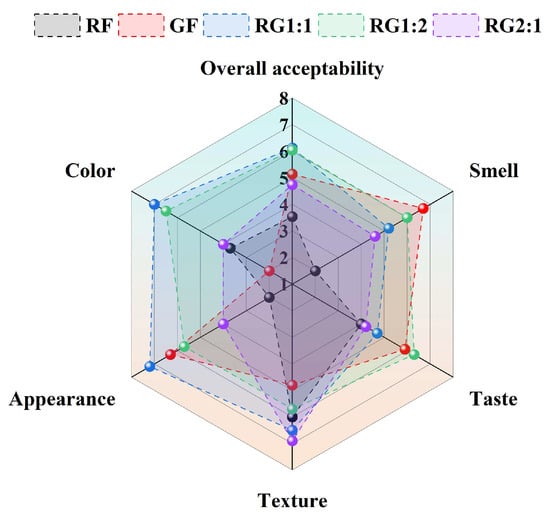
Figure 7.
Sensory evaluation results of 3D-printed gel samples.
4. Conclusions
This study explored the 3D printing performance of cereal–legume starch-based gels formulated with RABF and GBRF, highlighting the potential of these materials for personalized and functional food production. The rheological analysis revealed that the gels exhibited pseudoplastic behavior, with the RG1:2 formulation showing optimal color properties and the RG2:1 formulation demonstrating superior printing fidelity and structural stability. The microstructure analysis indicated that the interaction between RABF and GBRF components significantly influenced the gel network, with higher starch content enhancing the gel’s mechanical strength. Texture analysis further confirmed that the RG2:1 formulation exhibited the highest hardness, while RG1:2 showed the best springiness, suggesting that the ratio of RABF to GBRF can be tailored to achieve desired textural properties. According to the sensory evaluation, RG1:1 and RG1:2 exhibit better sensory qualities. Overall, the findings demonstrated that the combination of RABF and GBRF in specific ratios can enhance the printability and textural properties of cereal–legume starch-based gels, making them suitable for 3D food printing applications. This study provided a foundation for further research into the development of personalized and functional foods using 3DFP technology, with potential applications in catering to specific dietary needs and preferences. Moreover, the ideal application scenarios for all the blended formulations will be also investigated in future studies.
Author Contributions
Software, investigation, and writing—review and editing: R.L.; Investigation, methodology, and writing—original draft: Y.Z.; investigation, data curation and formal analysis: J.S.; conceptualization, funding acquisition, supervision, and writing—review and editing: L.S.; investigation, visualization, and formal analysis: Y.Y. All authors have read and agreed to the published version of the manuscript.
Funding
This work was supported by the China Postdoctoral Science Foundation (2022MD713725), Post-doctoral Science Foundation of Heilongjiang Province (LBH-Z21041), and Basic Research Fund for Undergraduate Universities under the Provincial Department of Education of Heilongjiang Province (2023-KYYWF-1165).
Institutional Review Board Statement
This study is based on the sensory evaluation of food products, specifically germinated brown rice and red bean-related samples. Participants only performed non-invasive sensory assessments such as taste, color, odor, and texture scoring. According to the National Standard of China (GB/T 10220-2012 Sensory Analysis—Methodology—General principles, GB/T 29605-2013 Sensory Analysis—Guidelines for sensory quality control of food products, GB/T 16291.1-2012 Sensory Analysis—Taste analysis—Part 1: General guidance, GB/T 23470.2-2009 Sensory Analysis—Tactile analysis—Part 2: General guidance) and the Measures for Ethical Review of Scientific and Technological Activities (Trial) and related regulations, this study does not involve human biological sample collection, medical, or psychological interventions. Participation was voluntary, and no sensitive personal information was collected; therefore, this study is exempt from ethical review.
Informed Consent Statement
Informed consent was obtained from all subjects involved in the study.
Data Availability Statement
The original contributions presented in the study are included in the article; further inquiries can be directed to the corresponding authors.
Conflicts of Interest
The authors declare no conflicts of interest.
References
- Godoi, F.C.; Prakash, S.; Bhandari, B.R. 3D printing technologies applied for food design: Status and prospects. J. Food Eng. 2016, 179, 44–54. [Google Scholar] [CrossRef]
- Ganguly, S.; Tang, X.S. 3D Printing of High Strength Thermally Stable Sustainable Lightweight Corrosion-Resistant Nanocomposite by Solvent Exchange Postprocessing. ACS Sustain. Chem. Eng. 2024, 13, 423–435. [Google Scholar] [CrossRef]
- Sharma, R.; Chandra Nath, P.; Kumar Hazarika, T.; Ojha, A.; Kumar Nayak, P.; Sridhar, K. Recent advances in 3D printing properties of natural food gels: Application of innovative food additives. Food Chem. 2024, 432, 137196. [Google Scholar] [CrossRef]
- Dankar, I.; Haddarah, A.; Omar, F.E.L.; Sepulcre, F.; Pujolà, M. 3D printing technology: The new era for food customization and elaboration. Trends Food Sci. Technol. 2018, 75, 231–242. [Google Scholar] [CrossRef]
- Derossi, A.; Husain, A.; Caporizzi, R.; Severini, C. Manufacturing personalized food for people uniqueness. An overview from traditional to emerging technologies. Crit. Rev. Food Sci. Nutr. 2020, 60, 1141–1159. [Google Scholar] [CrossRef]
- Baiano, A. 3D printed foods: A comprehensive review on technologies, nutritional value, safety, consumer attitude, regulatory framework, and economic and sustainability issues. Food Rev. Int. 2020, 38, 986–1016. [Google Scholar] [CrossRef]
- Kewuyemi, Y.O.; Kesa, H.; Adebo, O.A. Trends in functional food development with three-dimensional (3D) food printing technology: Prospects for value-added traditionally processed food products. Crit. Rev. Food Sci. Nutr. 2021, 62, 7866–7904. [Google Scholar] [CrossRef] [PubMed]
- Ma, T.; Zhang, Y.; Ruan, K.; Guo, H.; He, M.; Shi, X.; Guo, Y.; Kong, J.; Gu, J. Advances in 3D Printing for Polymer Composites: A Review. InfoMat 2024, 6, e12568. [Google Scholar] [CrossRef]
- Hübner, F.; Arendt, E.K. Germination of cereal grains as a way to improve the nutritional value: A review. Crit. Rev. Food Sci. Nutr. 2013, 53, 853–861. [Google Scholar] [CrossRef]
- Beaulieu, J.C.; Boue, S.M.; Goufo, P. Health-promoting germinated rice and value-added foods: A comprehensive and systematic review of germination effects on brown rice. Crit. Rev. Food Sci. Nutr. 2023, 63, 11570–11603. [Google Scholar] [CrossRef]
- Yuan, L.; Zheng, X.; Shen, L. Continuous microwave drying of germinated red adzuki bean: Effects of various drying conditions on drying behavior and quality attributes. J. Food Process. Preserv. 2022, 46, e17090. [Google Scholar] [CrossRef]
- Portanguen, S.; Tournayre, P.; Sicard, J.; Astruc, T.; Mirade, P. Toward the design of functional foods and biobased products by 3D printing: A review. Trends Food Sci. Technol. 2019, 86, 188–198. [Google Scholar] [CrossRef]
- Mantihal, S.; Prakash, S.; Bhandari, B. Textural modification of 3D printed dark chocolate by varying internal infill structure. Food Res. Int. 2019, 121, 648–657. [Google Scholar] [CrossRef]
- Wang, D.; Guo, J.; Wang, Y.; Yang, Y.; Jiang, B.; Li, D.; Feng, Z.; Liu, C. Whey protein isolate nanofibrils as emulsifying agent to improve printability of Cheddar cheese for 3D printing. Food Hydrocoll. 2023, 142, 108807. [Google Scholar] [CrossRef]
- Derossi, A.; Caporizzi, R.; Paolillo, M.; Severini, C. Programmable texture properties of cereal-based snack mediated by 3D printing technology. J. Food Eng. 2021, 289, 110160. [Google Scholar] [CrossRef]
- Wilson, A.; Anukiruthika, T.; Moses, J.A.; Anandharamakrishnan, C. Customized shapes for chicken meat–based products: Feasibility study on 3D-printed nuggets. Food Bioprocess Technol. 2020, 13, 1968–1983. [Google Scholar] [CrossRef]
- Escalante-Aburto, A.; Trujillo-De Santiago, G.; Álvarez, M.M.; Chuck-Hernández, C. Advances and prospective applications of 3D food printing for health improvement and personalized nutrition. Compr. Rev. Food Sci. Food Saf. 2021, 20, 5722–5741. [Google Scholar] [CrossRef]
- Khemacheevakul, K.; Wolodko, J.; Nguyen, H.; Wismer, W. Temporal Sensory Perceptions of Sugar-Reduced 3D Printed Chocolates. Foods 2021, 10, 2082. [Google Scholar] [CrossRef]
- Riantiningtyas, R.R.; Sager, V.F.; Chow, C.Y.; Thybo, C.D.; Bredie, W.L.; Ahrné, L. 3D printing of a high protein yoghurt-based gel: Effect of protein enrichment and gelatine on physical and sensory properties. Food Res. Int. 2021, 147, 110517. [Google Scholar] [CrossRef]
- Yu, X.; Wang, Y.; Zhao, W.; Li, S.; Pan, J.; Prakash, S.; Dong, X. Hydrophilic colloids (Konjac gum/Xanthan gum) in 3D printing of transitional food from fish paste. Food Hydrocoll. 2023, 137, 108333. [Google Scholar] [CrossRef]
- Rong, L.; Chen, X.; Shen, M.; Yang, J.; Qi, X.; Li, Y.; Xie, J. The application of 3D printing technology on starch-based product: A review. Trends Food Sci. Technol. 2023, 134, 149–161. [Google Scholar] [CrossRef]
- Waghmare, R.; Suryawanshi, D.; Karadbhajne, S. Designing 3D printable food based on fruit and vegetable products—Opportunities and challenges. J. Food Sci. Technol. 2022, 60, 1447–1460. [Google Scholar] [CrossRef] [PubMed]
- Jiang, H.; Zheng, L.; Zou, Y.; Tong, Z.; Han, S.; Wang, S. 3D food printing: Main components selection by considering rheological properties. Crit. Rev. Food Sci. Nutr. 2019, 59, 2335–2347. [Google Scholar] [CrossRef] [PubMed]
- Nsengiyumva, E.M.; Alexandridis, P. Xanthan gum in aqueous solutions: Fundamentals and applications. Int. J. Biol. Macromol. 2022, 216, 583–604. [Google Scholar] [CrossRef]
- Thombare, N.; Jha, U.; Mishra, S.; Siddiqui, M. Guar gum as a promising starting material for diverse applications: A review. Int. J. Biol. Macromol. 2016, 88, 361–372. [Google Scholar] [CrossRef]
- Strother, H.; Moss, R.; Mcsweeney, M.B. Comparison of 3D printed and molded carrots produced with gelatin, guar gum and xanthan gum. J. Texture Stud. 2020, 51, 852–860. [Google Scholar] [CrossRef] [PubMed]
- Zhu, H.; Liu, C.; Bai, C.; Chen, Q.; Zhao, X.; Liu, C.; Zheng, X.; Shen, L. Effects of Microwave Vacuum Drying on Drying Characteristics, Quality Attributes and Starch Structure of Germinated Brown Rice. Int. J. Biol. Macromol. 2024, 282, 137153. [Google Scholar] [CrossRef]
- Huang, M.-S.; Zhang, M.; Bhandari, B. Assessing the 3D Printing Precision and Texture Properties of Brown Rice Induced by Infill Levels and Printing Variables. Food Bioprocess Technol. 2019, 12, 1185–1196. [Google Scholar] [CrossRef]
- Chen, H.; Xie, F.; Chen, L.; Zheng, B. Effect of rheological properties of potato, rice and corn starches on their hot-extrusion 3D printing behaviors. J. Food Eng. 2019, 244, 150–158. [Google Scholar] [CrossRef]
- Liu, Z.; Zhang, M.; Bhandari, B. Effect of gums on the rheological, microstructural and extrusion printing characteristics of mashed potatoes. Int. J. Biol. Macromol. 2018, 117, 1179–1187. [Google Scholar] [CrossRef]
- Shen, L.; Gao, M.; Zhu, Y.; Liu, C.; Wang, L.; Kamruzzaman, M.; Liu, C.; Zheng, X. Microwave drying of germinated brown rice: Correlation of drying characteristics with the final quality. Innov. Food Sci. Emerg. Technol. 2021, 70, 102673. [Google Scholar] [CrossRef]
- Yang, Z.; Lu, K.; Zhao, Y.; Shi, X.; Mao, W.; Zheng, B.; Xu, Y.; Gao, P.; Zhou, R. Effects of different heat-induced setting methods on the structural stability and properties of 3D-printed surimi gels. LWT 2024, 198, 115957. [Google Scholar] [CrossRef]
- Sanusi, M.S.; Sunmonu, M.O.; Alasi, S.O.; Adebiyi, A.A.; Tajudeen, A.A. Composition, bioactive constituents and glycemic index of brown rice-watermelon seeds extruded snacks as stimulated by extrusion conditions. Appl. Food Res. 2023, 3, 100287. [Google Scholar] [CrossRef]
- Shen, L.; Zhu, Y.; Wang, L.; Liu, C.; Liu, C.; Zheng, X. Improvement of cooking quality of germinated brown rice attributed to the fissures caused by microwave drying. J. Food Sci. Technol. 2019, 56, 2737–2749. [Google Scholar] [CrossRef]
- Li, Y.; Zhang, J.; Wang, J.; Ren, J.; Cao, C.; Liu, Q.; Huang, X. Evaluation of drying characteristics and quality attributes for microwave vacuum drying of pork skin crisps. Foods 2024, 13, 4020. [Google Scholar] [CrossRef]
- Islam, M.F.; Islam, S.; Miah, M.A.S.; Bhuiyan, M.N.I.; Abedin, N.; Mondol, M.M.H.; Sultana, S.; Linkon, K.M.M.R. Quality assessment and sensory evaluation of green banana starch enriched instant noodles. Appl. Food Res. 2024, 4, 100431. [Google Scholar] [CrossRef]
- Bai, J.; Dong, M.; Li, J.; Tian, L.; Xiong, D.; Jia, J.; Yang, L.; Liu, X.; Duan, X. Effects of egg white on physicochemical and functional characteristics of steamed cold noodles (a wheat starch gel food). LWT 2022, 169, 114057. [Google Scholar] [CrossRef]
- Jiang, X.; Dai, W.; Yan, Q.; Chen, D.; Li, Z.; Sun, X.; Ding, J.; Li, Z.; Fang, Y. Glutinous rice gel as all-natural ink supply for extrusion-based food 3D printing—the chemical basis of gel printability. Food Chem. 2025, 467, 142310. [Google Scholar] [CrossRef] [PubMed]
- Li, J.; Xu, X.; Zhao, Q.; Zhang, J.; Zhu, P.; Xu, D.; Jin, Y.; Wu, F. Effects of ratios of A- and B-type wheat starch on liangpi (a starch gel food) quality and its potential mechanism. Carbohydr. Polym. 2025, 352, 123194. [Google Scholar] [CrossRef]
- Liu, Y.; Tang, T.; Duan, S.; Qin, Z.; Li, C.; Zhang, Z.; Liu, A.; Wu, D.; Chen, H.; Han, G. Effects of sodium alginate and rice variety on the physicochemical characteristics and 3D printing feasibility of rice paste. LWT 2020, 127, 109360. [Google Scholar] [CrossRef]
- Chuanxing, F.; Qi, W.; Hui, L.; Quancheng, Z.; Wang, M. Effects of pea protein on the properties of potato starch-based 3D printing materials. Int. J. Food Eng. 2018, 14, 20170297. [Google Scholar] [CrossRef]
- Bareen, M.A.; Sahu, J.K.; Prakash, S.; Bhandari, B.; Naik, S. A novel approach to produce ready-to-eat sweetmeats with variable textures using 3D printing. J. Food Eng. 2023, 344, 111410. [Google Scholar] [CrossRef]
- Mantihal, S.; Prakash, S.; Godoi, F.C.; Bhandari, B. Effect of additives on thermal, rheological and tribological properties of 3D printed dark chocolate. Food Res. Int. 2019, 119, 161–169. [Google Scholar] [CrossRef] [PubMed]
- Ma, S.; Zhu, P.; Wang, M. Effects of konjac glucomannan on pasting and rheological properties of corn starch. Food Hydrocoll. 2019, 89, 234–240. [Google Scholar] [CrossRef]
- Liu, Y.; Sun, Q.; Wei, S.; Xia, Q.; Pan, Y.; Liu, S.; Ji, H.; Deng, C.; Hao, J. LF-NMR as a tool for predicting the 3D printability of surimi-starch systems. Food Chem. 2022, 374, 131727. [Google Scholar] [CrossRef]
- Paxton, N.; Smolan, W.; Böck, T.; Melchels, F.; Groll, J.; Jungst, T. Proposal to assess printability of bioinks for extrusion-based bioprinting and evaluation of rheological properties governing bioprintability. Biofabrication 2017, 9, 44107. [Google Scholar] [CrossRef]
- Zhang, M.; Vora, A.; Han, W.; Wojtecki, R.J.; Maune, H.; Le, A.B.A.; Thompson, L.E.; McClelland, G.M.; Ribet, F.; Engler, A.C.; et al. Dual-Responsive Hydrogels for Direct-Write 3D Printing. Macromolecules 2015, 48, 6482–6488. [Google Scholar] [CrossRef]
- Liu, Z.; Bhandari, B.; Prakash, S.; Mantihal, S.; Zhang, M. Linking rheology and printability of a multicomponent gel system of carrageenan-xanthan-starch in extrusion based additive manufacturing. Food Hydrocoll. 2019, 87, 413–424. [Google Scholar] [CrossRef]
- Cheng, Y.; Yuqing, H.; Xiao, L.; Gao, W.; Kang, X.; Sui, J.; Cui, B. Impact of Starch Amylose and Amylopectin on the Rheological and 3D Printing Properties of Cornstarch. Int. J. Biol. Macromol. 2024, 278, 134403. [Google Scholar] [CrossRef]
- Maldonado-Rosas, R.; Tejada-Ortigoza, V.; Cuan-Urquizo, E.; Mendoza-Cachú, D.; Morales-de La Pena, M.; Alvarado-Orozco, J.M.; Campanella, O.H. Evaluation of rheology and printability of 3D printing nutritious food with complex formulations. Addit. Manuf. 2022, 58, 103030. [Google Scholar] [CrossRef]
- Huang, M.-S.; Zhang, M.; Guo, C.-F. 3D printability of brown rice gel modified by some food hydrocolloids. J. Food Process. Preserv. 2020, 44, e14502. [Google Scholar] [CrossRef]
- Mantihal, S.; Prakash, S.; Godoi, F.C.; Bhandari, B. Optimization of chocolate 3D printing by correlating thermal and flow properties with 3D structure modeling. Innov. Food Sci. Emerg. Technol. 2017, 44, 21–29. [Google Scholar] [CrossRef]
- Zhang, G.; Chen, Y.; Pan, J.; Qiu, Y.; Cui, P.; Lyu, F.; Zhang, J. Effect of guar gum on the physicochemical properties and in vitro digestive characteristics of extruded starches. Int. J. Biol. Macromol. 2024, 275, 133176. [Google Scholar] [CrossRef] [PubMed]
- Yang, C.; Zhong, F.; Douglas Goff, H.; Li, Y. Study on starch-protein interactions and their effects on physicochemical and digestible properties of the blends. Food Chem. 2019, 280, 51–58. [Google Scholar] [CrossRef]
- Liu, Y.; Tang, T.; Duan, S.; Qin, Z.; Zhao, H.; Wang, M.; Li, C.; Zhang, Z.; Liu, A.; Han, G. Applicability of rice doughs as promising food materials in extrusion-based 3D printing. Food Bioprocess Technol. 2020, 13, 548–563. [Google Scholar] [CrossRef]
- Wijesekara, T.; Xu, B. A critical review on the stability of natural food pigments and stabilization techniques. Food Res. Int. 2024, 179, 114011. [Google Scholar] [CrossRef]
- Lan, T.; Qian, S.; Song, T.; Zhang, H.; Liu, J. The chromogenic mechanism of natural pigments and the methods and techniques to improve their stability: A systematic review. Food Chem. 2023, 407, 134875. [Google Scholar] [CrossRef]
- Liu, Y.; Sun, Q.; Wei, S.; Xia, Q.; Pan, Y.; Ji, H.; Deng, C.; Hao, J.; Liu, S. Insight into the correlations among rheological behaviour, protein molecular structure and 3D printability during the processing of surimi from golden pompano (Trachinotus ovatus). Food Chem. 2022, 371, 131046. [Google Scholar] [CrossRef]
- Liu, Y.; Li, D.; Hu, J.; Li, P.; He, L.; Yang, N.; Nishinari, K. New insight into synergistic interaction between the backbone or side chain of xanthan gum and the backbone of Gleditsia sinensis polysaccharide. Int. J. Biol. Macromol. 2024, 279, 135396. [Google Scholar] [CrossRef]
- Wanjun, X.; Qingqing, Y.; Yaqi, Z.; Yu, F.; Qiaoyu, C.; Ruichang, G.; Yulong, B. Insight into the mechanism of the decrease in mechanical strength and water-holding capacity of gels made from oxidized gelatin. Int. J. Biol. Macromol. 2024, 258, 128842. [Google Scholar] [CrossRef]
- Jiang, Q.; Wei, X.; Liu, Q.; Zhang, T.; Chen, Q.; Yu, X.; Jiang, H. Rheo-fermentation properties of bread dough with different gluten contents processed by 3D printing. Food Chem. 2024, 433, 137318. [Google Scholar] [CrossRef] [PubMed]
- Zhong, Y.; Zeng, S.; Lv, Y.; Lv, W.; Xiao, H.; Sheng, S. Effect of guar gum on the rheological properties, microstructure and 3D printing performance of egg yolk powder-potato starch composite gel. Food Hydrocoll. 2024, 153, 110018. [Google Scholar] [CrossRef]
- Yan, X.; Jia, Y.; Man, H.; Liu, L.; Sun, S.; Qi, B.; Li, Y. Intermolecular interactions and gel properties of composite agglomerative networks based on oppositely charged polymers: Effects of pH and ionic strength. Food Hydrocoll. 2023, 139, 108557. [Google Scholar] [CrossRef]
- Jie, Y.; Chen, F. Progress in the Application of Food-Grade Emulsions. Foods 2022, 11, 2883. [Google Scholar] [CrossRef]
- Zhao, N.; Guo, C.; Liu, Z.; Chen, L.; Hu, Y.; Han, M.; Huang, F.; Kang, Z.; Feng, X. Effects of different hydrocolloids on the 3D printing and thermal stability of chicken paste. Int. J. Biol. Macromol. 2024, 277, 134006. [Google Scholar] [CrossRef] [PubMed]
- Carvajal-Mena, N.; Tabilo-Munizaga, G.; Pérez-Won, M.; Herrera-Lavados, C.; Lemus-Mondaca, R.; Moreno-Osorio, L. Evaluation of physicochemical properties of starch-protein gels: Printability and postprocessing. LWT 2023, 182, 114797. [Google Scholar] [CrossRef]
- Guénard-Lampron, V.; Masson, M.; Leichtnam, O.; Blumenthal, D. Impact of 3D printing and post-processing parameters on shape, texture and microstructure of carrot appetizer cake. Innov. Food Sci. Emerg. Technol. 2021, 72, 102738. [Google Scholar] [CrossRef]
Disclaimer/Publisher’s Note: The statements, opinions and data contained in all publications are solely those of the individual author(s) and contributor(s) and not of MDPI and/or the editor(s). MDPI and/or the editor(s) disclaim responsibility for any injury to people or property resulting from any ideas, methods, instructions or products referred to in the content. |
© 2025 by the authors. Licensee MDPI, Basel, Switzerland. This article is an open access article distributed under the terms and conditions of the Creative Commons Attribution (CC BY) license (https://creativecommons.org/licenses/by/4.0/).
